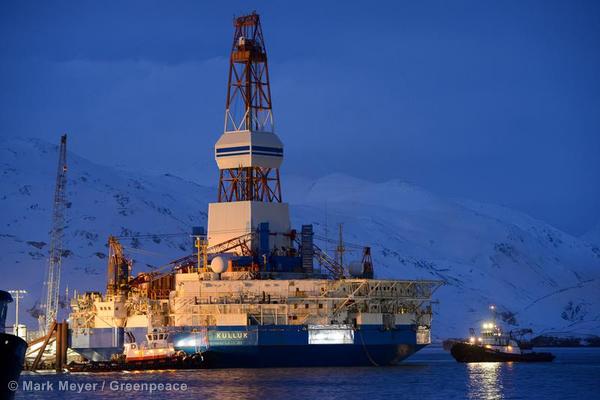
Shell's drill ship the Kulluk is towed out of the Arctic after the oil company canceled its 2013 drilling plans
The end of 2012 and first months of 2013 have seen a remarkable change in the fight to protect the Arctic from risky and dangerous oil exploration. Three oil majors Total,Statoiland Conoco-Phillips – have withdrawn from drilling projects in the far North. Shell of course has also famously paused its drilling in the Chukchi in the Alaskan Arctic after a series of costly and embarrassing accidents, though thankfully at least without a major oil spill or loss of life. This pause though allegedly voluntary, would surely have been imposed upon the subsequent publication of the US Department of the Interior assessment of Shells 2012 Arctic operations published just days later, which highlighted inadequate performance in 5 of 7 key areas identified by Interior Department as essential for safe and responsible offshore drilling. Greenpeace argues, not unexpectedly and for a variety of reasons, that no drilling in the Arctic can be safe and responsible. But for the US Department of the Interior to label one of the most risk averse of the oil majors inadequate is worth noting.
Yet as recently as 2011 when speaking to managers of some of the biggest ethical/socially responsible investment funds in the UK, Greenpeace and colleagues at Platform and ShareAction were told with a certain amount of sadness and resignation that Arctic drilling was almost a certainty and would inevitably proceed. So what happened?
The truth was that a lot had already happened, but the investors hadnt really noticed, or if they had noticed, didnt understand. First of all, the age of easy oil had passed and the oil majors had lost access to much of what remained to the national oil companies in the Middle East, Russia and Latin America. In addition, by 2010 even disgraced former BP chief Tony Hayward knew oil consumption in the developed world had peaked. Yet in order to justify further dangerous and costly exploration in places like the Arctic companies like Shell, BP, Statoil and Conoco-Phillips had to convince their shareholders that chasing the last drop of oil to the last pristine wilderness on earth was essential to their financial well-being. They did this by emphasizing future consumptionandscenariosthat pushed oil use beyond economic and environmental limits.
But even if the penny hadnt dropped for investors who had a vested short-term interest in the massive profits still being booked the oil majors it should have been apparent to Governments that allowing oil companies into the Arctic was creating unacceptable risks to for both the Arctic environment and the global climate. Yet when the UK Government was pushed to support a call by the Parliamentary Environmental Audit Committeefor a moratorium on Arctic drilling the UK Government refused, perversely saying that Arctic oil was essential to securing a safe future for the climate.It isnt and governments around the world almost certainly know that, but thats not the point: opposing Arctic drilling would put governments around the world in conflict with some of the most powerful companies in the world.
But now, perhaps, just perhaps, the tide is beginning to turn. And perversely, that turn may have started in the wake of the worst peacetime oil spill in history the Deepwater Horizon in April 2010. In the Gulf of Mexico, that accident blighted an entire industry, and almost certainly lead to the increased scrutiny – and more stringent regulation – on Arctic drilling, not just in the US but Europe. In turn this contributes to rising costs and complexity (as Shell discovered to their cost in 2012) and a less attractive environment for investors, according to analysts at financial institutions including HSBC,Credit Agricole,Natixis and Societe Generale, as well as influential commentators likeNick Butler in the Financial Times
As the fundamentally flawed economic justification for risky Arctic drilling adventures start to pale, other considerations begin to get a look in including climate change. The Arctic is warming faster than any other region on earth and its vulnerability to climate change is highlighted by the fact in the words of James Turner, currently skiing to the North Pole as part of the a youth journey to save the Arctic, that since the invention of the mouse, we’ve lost three quarters of summer Arctic sea ice. A level of oil use that would justify Arctic exploration in economic terms alone, would almost certainly result in catastrophic climate change according – not to Greenpeace – but to analysis by the International Energy Agency who acknowledged that to have even a 50 percent chance of avoiding catastrophic climate, two thirds of known fossil fuel reserves need to remain under ground.
Its likely and lucky – that a combination of factors is slowing the resource rush to the Arctic but whether its fast enough to avoid the train wreck thats coming is still open to question. But inevitable? Perhaps not any more


